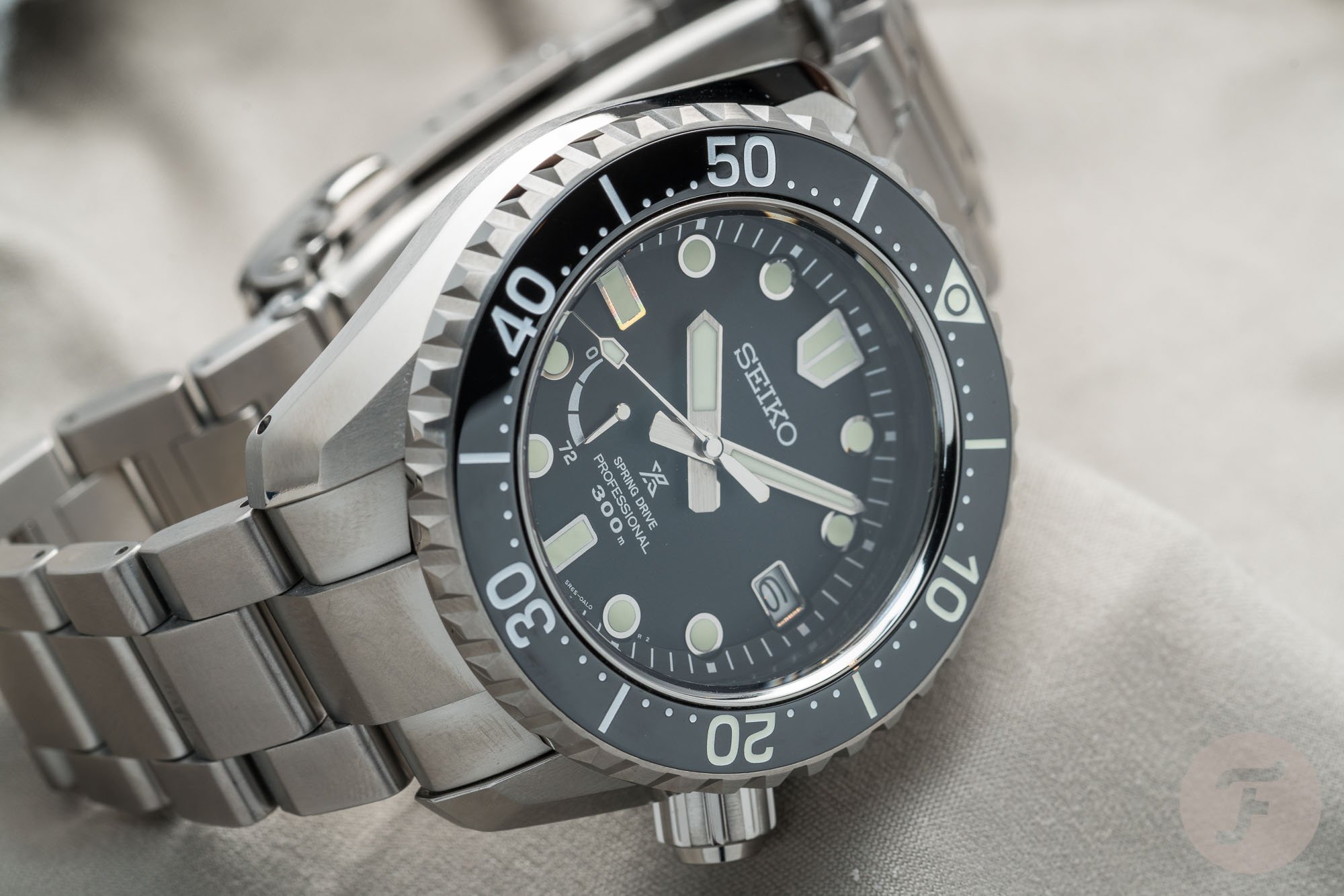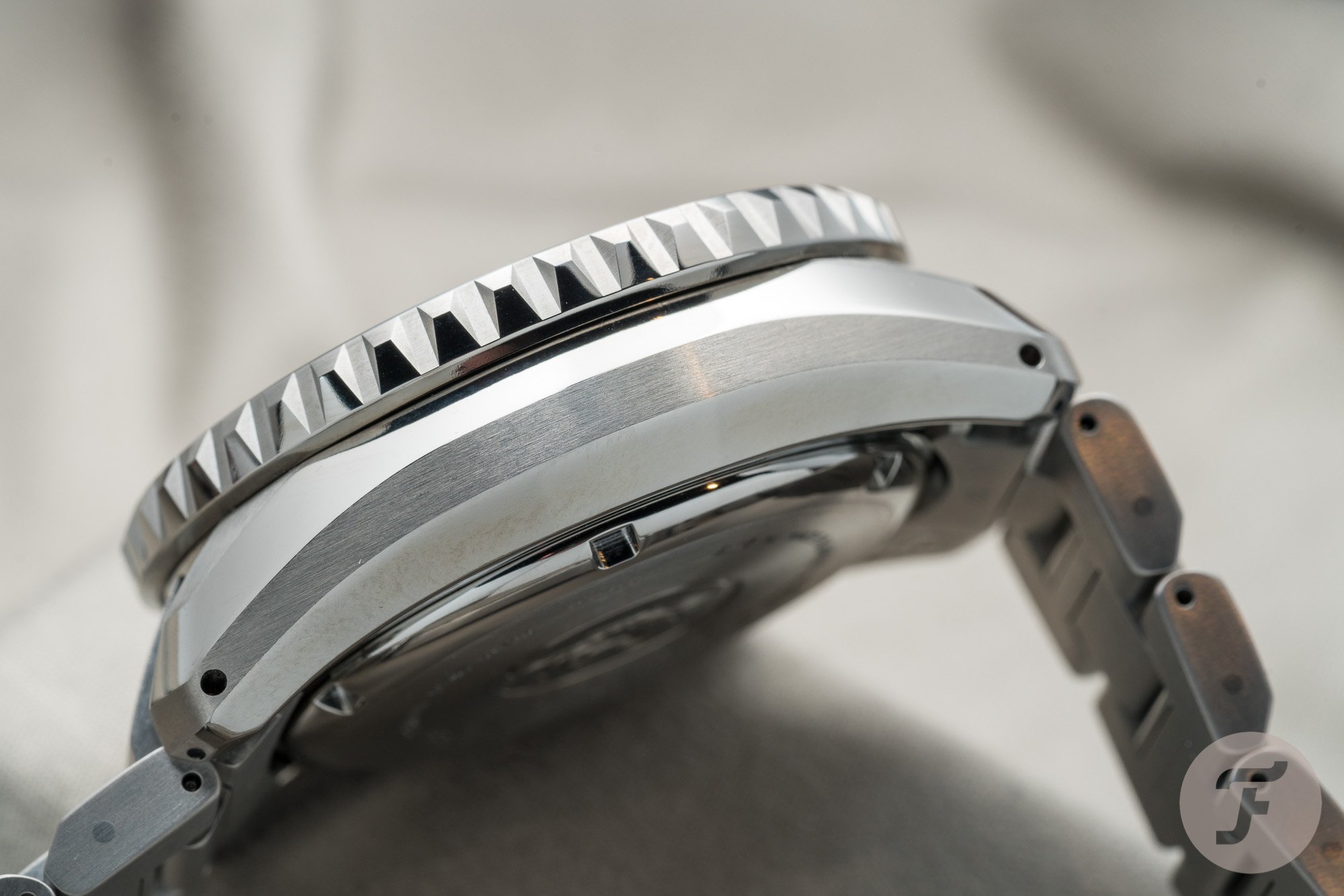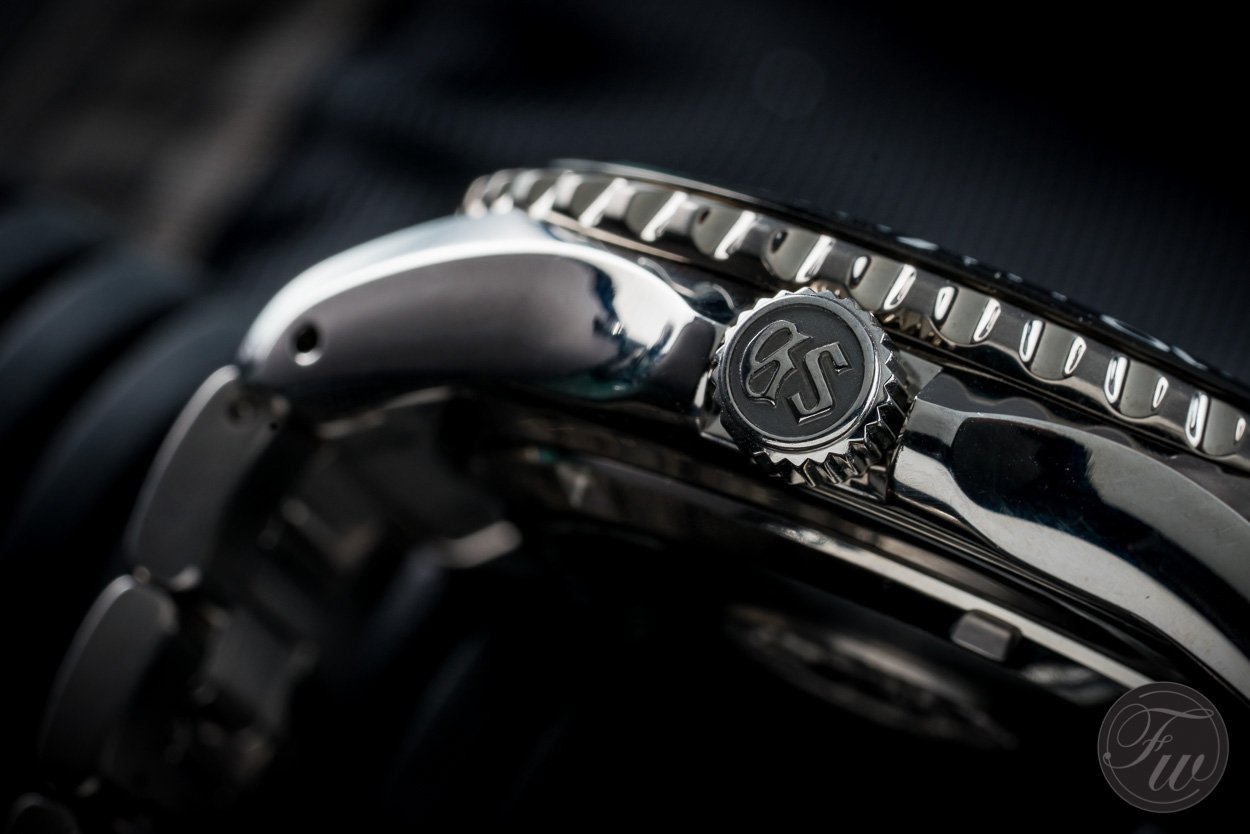Sunday Morning Showdown: The Price Is Right — Seiko Vs. Grand Seiko
In our Sunday Morning Showdown, two of our writers go head-to-head in an epic showdown for the ages. Strong opinions and hysterical hyperbole are welcome (so feel free to join in with the fun in the comments section below). And don’t forget to let us know which watches you’d like to see torn to shreds/effusively exalted next week. We’ll try and feature as many of our readers’ choices as we can. This week serves up a conundrum. With the prices between Seiko and Grand Seiko converging, our writers consider what this means for the options. Do you part with your cash for the highest-end Spring Drive diver from Seiko, or go in through the entry point with a similar Grand Seiko?
Specifically, we are focussing on the Seiko SNR029J1 and Grand Seiko SBGA231G. It’s quite a quandary that Seiko has snookered itself in. How did we get to the point that the typically budget-friendly Seiko option reaches the point of encroaching on the territory of its premium bigger brother, Grand Seiko? Surely, this defeats the object of splitting these brands’ hierarchy to cover both ends of the market?
Seiko Vs. Grand Seiko
This is where you come in to let us know your stance on the Japanese giant’s current pricing strategy. In one way, Seiko is one of the most accomplished brands in watches. Not only that, but Seiko has a long and storied history of developing innovative dive watches. The Seiko SNR029 could be seen as the culmination of Seiko’s expertise distilled into the perfect companion for a deep dive under the surface. With that is a price of €6,100 that symbolizes that prowess. But let’s not forget this Seiko SNR029 is manufactured on the same line as its big brother. It even receives the lauded Spring Drive movement.
On the other hand, Grand Seiko itself is considered the premium wristwatch outfit under the Seiko-Epson umbrella. Therefore, any Grand Seiko watch gets the royal treatment of being developed in the land of the Rising Sun. The dedication to any Grand Seiko is at a level most high-end Swiss brands could only wish for. And slowly and steadily, the Grand Seiko marque is becoming synonymous with high precision, comfort, and quality. Even still, with such a tall ceiling at Grand Seiko, do you only want to go for the entry-level with the SBGA231 at €7,200? Or do you make the leap for the bells and whistles dive watch options like the SBGH257?
Back in black
Before we get ahead of ourselves, let’s take a look at how our jet-black jaw-dropping Showdown unfolded. Even with the recency bias of the IWC, the votes came flooding in for the Omega Speedmaster Dark Side of the Moon. A very appropriate 69% took the ceramic cult classic to the moon and back over the IWC Pilot’s Chronograph “Tribute To 3705”. Although there were plenty of vocal supporters for the IWC in the comments section, the DSotM fans kept stealthy to cast their vote.
Now we’re all caught up, let’s turn our attention to this week’s inter-brand bust-up.
Jorg — Seiko Prospex LX SNR029J1
Welcome to the Sunday Morning Showdown social experiment. Today’s topic? The power of brand perception. Specifically, is there a reason to choose a Seiko over Grand Seiko when the prices are within striking distance of each other?
First up, when Ben suggested this match-up, I was slightly hesitant. My first reaction was, “who in their right mind would ever choose the Seiko over the Grand Seiko for the same cash?” Typically Seiko offers the best bang-for-buck for the budget-conscious buyer. In recent times, that mantra is drifting somewhat into Grand Seiko’s domain. But when the two line up on a pricing matrix, you have to question whether the Seiko is no more a fish out of the water, but a fish launched into the stratosphere. The sticker price, notwithstanding, the Seiko has to really sell the sum of its parts compellingly. And that’s the kind of challenge to gird one’s loins.
The Seiko Prospex LX SNR029J1 is part of Seiko’s elite series of diving watches. The Propex LX line was introduced during Baseworld in 2019 as a series of six titanium divers with the same 44.8mm case. All powered by Seiko’s famous Spring Drive movement. Three of the six models have a black-coated case and are supplied on silicone and leather straps. The three regular titanium models come on a matching titanium bracelet. And out of the three, the SNR029 is the one that has the most appeal to me. Its aesthetic reminds me of the familiar Marinemaster 300, an iconic Seiko design that I love. Since the introduction two years ago, Seiko introduced two limited-edition models; including the deep green SNR029, which we discuss today.
Designed by Ken Okuyama
For the design of the SNR029, Seiko called in the help of famous Japanese designer Ken Okuyama. Okuyuma designed the Ferrari Enzo during his time at Pininfarina. I could sum up more of his car designs, Ben, but come on…the Enzo speaks for itself.
Ben: I am on the ropes here, Jorg — the Enzo is my dream Ferrari. I know the Ferrari Enzo Ferrari, so good they named it twice, caused a stir amongst the automotive press. But I consider it such an iconic design that is fully deserving of the moniker.
I am a child of the Testarossa generation, but the Enzo is a thing of sheer beauty. So kudos to Seiko for bringing in the legendary designer for the development of the Prospex LX line. Okuyuma’s main task was to develop a case design that fits the concept of light reflecting on the case facets in unique ways. The LX in the series’s name comes from lux, the Latin word for light. And by creating a unique case design, the SNR029 is not only a step up from the Marinemaster 300, but it also starts to show up your apparent “Grand” Seiko SBGA231.
On top of that, Okuyuma was tasked to design a comfortable case despite the 44.8mm×15.7mm dimensions. And in Robert-Jan’s review, you can read that Okuyama succeeded in creating a case that does exactly that. I have to say; I love the looks of the case. The sharp lines and the beautiful lugs give the case a powerful presence. Another feature I prefer over the Grand Seiko is the design of the bracelet. Seiko has a reputation for not creating the most beautiful or exciting bracelets in the industry. But for the SNR029, Seiko hit it out of the park. It may appear as just a simple three-link construction, but the flat sides and steep curves play with light and shadow even with a brushed finish.
The real heavyweight
Speaking of finishing: Grand Seiko is known for its superiority in this field. I’ll spare you the dreaded Z-word, but I will mention this finishing is also applied to this SNR029J1. The combination of the great bracelet, case design, and finishing has me leaning towards the Seiko. I’ve surprised even myself, as I felt overcoming the brand recognition of Grand Seiko was insurmountable.
Now to deliver the final blows: My first strike is with the hands — hour and minute hands of Grand Seiko dive watches to be more precise. If there is one reason above all for siding with the Seiko and saving €1,100, it has to be the whacky GS hands. The SBGA231 has a short fat hour hand and a disproportionally long minute hand in a more baroque style than modern sports watch. A second strike is a theoretical one with us being desk divers, but the water-resistance of the Seiko is 300 meters where the Grand Seiko has a water-resistance of “only” 200 meters.
Ben: ISO 6425 stipulates a minimum of 100 meters for a dive watch, Jorg, so we’re both in the clear. No need to be petty, I’m sure both can withstand a few splashes of craft beer.
And what about titanium itself? Often a complaint is the less than reassuring mass of titanium compared to the same volume of steel. But when it comes to the Seiko SNR029, it’s closer in weight to a regular steel diver than the titanium Grand Seiko SBGA231. The Seiko weighs 162 grams, whereas the Grand Seiko comes in at only 137 grams. The SNR029 weighs as much as the Rolex Submariner and Omega Seamaster Diver 300M, both in steel. It manages to be a dive watch with plenty of wrist presence that’s no heavier than the best of the Swiss biz.
Spring Drive Caliber 5R65
Lastly is the Seiko Spring Drive Caliber 5R65. In essence, it’s the same movement as the Grand Seiko Caliber 9R65 that powers your SBGA231. The only differences between the two are the finish of the rotor bridge and the shape of the rotor. As both are safely tucked away underneath their titanium case backs, the level of finishing is not precisely on show, so not a factor. I love Spring Drive movements for their ingenious technique resulting in supreme accuracy. I keep struggling with one visual hurdle, and that’s the power reserve indicator on the dial. As someone who likes clean dials, it’s an element I could do without. However, both our choices elect to display the remaining power despite the automatic winding.
With specs laid out on the table, it’s now time to discuss the power of branding. At a list price of €6,100, the SNR029 pushes the boundaries of what Seiko can get away with. It’s not a price we haven’t seen before though. The recent 55th Anniversary divers come in for a few hundred Euros more, so it’s not entirely outside Seiko’s wheelhouse. Still, it’s a big chunk of change for a brand that also has Propex models that cost one-tenth of this watch’s list price.
As a result, it would be easy to come up with a list of Seiko alternatives I’d rather spend my money on and save some dough. But that’s not how our Sunday Morning Showdown works, and I hope I’ve made my case for the Seiko SNR029 over the Grand Seiko SBGA231. And honestly, Ben, I am not sure the power of the Grand Seiko brand is enough to outweigh the sheer pedal to the metal performance of this Seiko.
Ben — Grand Seiko SBGA231
Yes, you’re right, Jorg. This was a fight that a madman could have only devised. What’s worse, I could have made this even harder for you by choosing the SBGA229G. This Grand Seiko has a retail price of €6,200, so it is only €100 more than your Seiko. I feel sorry for the sales rep trying to explain that one to a bemused customer in the Seiko boutique. However, in the interest of fairness and to dispel our audience’s ire, it made sense to even the score. This fight only encompasses titanium Spring Drive dive watches. The SBGA229 has a stainless steel case, whereas the Grand Seiko SBGA231 has a titanium case to match the SNR029.
Jorg: If it would have been the steel SBGA229, I would have definitely needed help from the best Seiko sales rep in the world.
Even with the handicap of an extra €1,100 for the Grand Seiko, I am still feeling confident with my choice. Not only is it the gateway into professional Grand Seiko watches, but the appearance is also closer in layout to familiar dive watches. I get that the 4 o’clock crown is synonymous with Seiko since the Silver Wave, but it’s not always the preferred option. The offbeat crown may improve comfort, but it casts an awkward silhouette that makes it less adaptable. The SBGA231 provides that familiarity with the 3 o’clock crown and flowing crown guards.
All in the details
With the name Grand Seiko, even its entry-level pieces carries some cachet. What makes the difference may not be as in your face as the SNR029 — I’m still reeling from that Enzo name drop, by the way. But it’s in the details that lift the GS above the Seiko. The deep knurling on the bezel has a professional feel that’s tactile yet tasteful. It’s not only beneficial for aquatic escapades but blends into above surface excursions. The grade 5 titanium is referred to as “high-intensity” by Grand Seiko to signal the alloy is more resistant than the average titanium alloy to knocks and corrosion.
You may have made strides to avoid the Z-word, but I am just going to say it now — Zaratsu! Perhaps you were preventing the eye-rolls from the readers, but I have a sneaking suspicion that the sparseness of Zaratsu polishing on the SNR029 was barely worth the mention. In my eyes, I can only notice the tin-plate finishing style on the lug bevels of your Seiko.
Jorg: The full length of the case actually features Zaratsu polishing. In combination with the large parts that have a brushed finish, the Zaratsu-polished parts really stand out nicely. See, I’m not afraid to use it.
Conversely, the SBGA231 has ample use of this masterful technique on multiple facets, including the bracelet’s inter-links. The entirety of the case sides are where it comes into its own, proving the price bump was worth it. Not only is it a pleasing aesthetic, but it’s a dying art the Japanese watchmakers are maintaining for generations to come.
Advanced warning ahead for mentions of the Z-word
Sallaz polishing, as it is colloquially referred to in Europe, originates in Swiss watchmaking. But the technique is seldom employed due to the intense training required to master the trade. Essentially, a tin plate spins at high revs with the watchmaker applying the appropriate force against the component’s surface. The outcome is to achieve distortion-free surfaces that appear as reflective as a mirror. Yet, that goes nowhere to describe the skill involved in controlling the machine’s RPM, obtaining the correct angle, and simply knowing when to stop. In Taro Tanaka’s “The Grammar of Design,” mirror polishing was a mandate set amongst many other stipulations to provide consistent quality at Seiko. Nowhere is the better on display than with the Grand Seiko SBGA231.
Jorg: You are really going full-on Zaratsu for the win, aren’t you Ben?
I get it; it’s a low blow to bring the extensive use of Zaratsu of the Grand Seiko into the equation. But it shows that even on the low-end scale of Grand Seiko, the finished result is refined as the best Seiko can aim for. With that refinement comes a slightly more wearable 44.2mm×14mm case that wears slimmer and lighter. While it comes in much lighter than the Seiko, the hand-finished nature of the SBGA231 provides the reassurance of quality without the need for unnecessary heft. The metallic bezel with ADLC coating is perhaps the only area where I feel the more pricey options in the Grand Seiko range start to show their worth. A ceramic bezel would not go amiss, but this bezel’s appearance at least closely resembles the sheen of ceramic.
Wait, how much?
Ok, so I may have devised this match-up, but it was out of pure curiosity. €6,100 for a Seiko is still something I’m racking my brains about. You’ve put in some great work to appeal to the voters on justifying the Seiko, Jorg, but I cannot help but feel the marketing exec sneezed and hit an extra zero while jotting up the price of the SNR029. The only thing that shuts down my theory is the now persistent price hike we see across both sides of the Seiko brands.
This now, to me, only serves in favor of the SBGA231. This could be the last bastion of hope for Grand Seiko, being the ultimate in affordable high-end professional-grade wristwatches. With it comes all the GS tropes you have learned to expect. And this particular SBGA231 displays all those key features with a subtle dark green dial and golden touches with the logo. Making that jump to the Grand Seiko seems like a no-brainer for me.
Final thoughts
Jorg: I have to say this really is a tricky one. The key to this is in the perception of the Seiko brand. Just like you, I’m struggling to find reasons why Seiko would enter the pricing boundary of Grand Seiko? It’s the range that Grand Seiko has fought hard to establish. And the hard work has paid off because an ever-growing number of people will now seriously consider a Grand Seiko over a Rolex or an Omega.
Being the best resonates with watch enthusiasts
The brand is very much focused on craftsmanship and technical excellence and that focus resonates with watch enthusiasts including myself. And it’s specifically this well-crafted image of wanting to be the best, that makes it hard to accept that its smaller brother Seiko could easily be in the same territory. Seiko, a brand that has the core of its watches in the €500–€1,500 price range. And they want to compete with the best?
And on many functional levels, they can — not in the least because they benefit from Grand Seiko. The SNR029 shows exactly that. And when it comes to the design, I actually prefer it. The case shape, the hands, and the bracelet make it look better than the SBGA231. So the head definitely says Seiko, but my heart is heavily questioning what’s going on here. That’s why I am curious to find out what our readers think, Ben.
Ben: I agree, Jorg. This is one we can make the case for each preference ad nauseum. But I am now keen to hear from the masses on their stance.
Is it really an easy win for the Grand Seiko? Or does the Seiko win your heart. Vote now and share your thoughts in the comments below.












